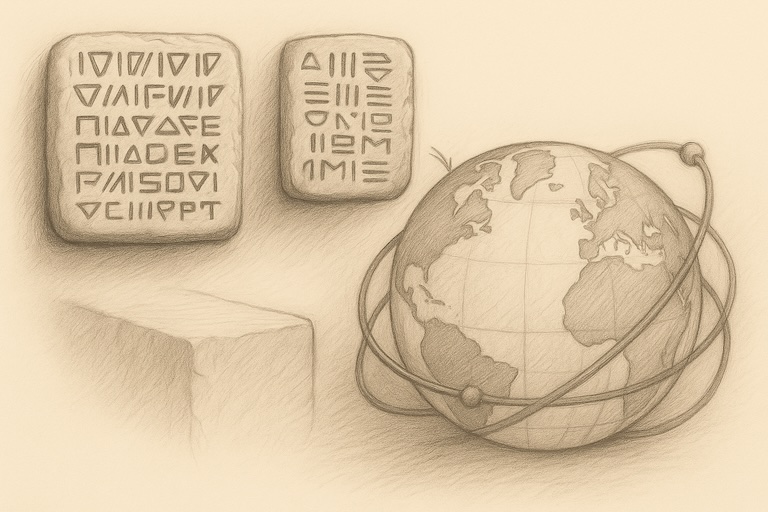Oral Traditions and the Limits of Memory
Human civilization has always been closely tied to the amount of information we can process and store. For example, when societies transitioned from hunter-gatherer lifestyles to farming, the ability to record and pass down crucial agricultural knowledge—such as when to plant crops, when to harvest, and how to manage farming challenges—became essential. Initially, this knowledge was transmitted orally, making it prone to loss and distortion over generations.
The Birth of Writing
The invention of writing around 3400 BCE in Mesopotamia marked a significant leap forward. Early written records were inscribed on materials such as clay tablets in Mesopotamia and stone in ancient Egypt. Similarly, in ancient China, early writings appeared on oracle bones and bamboo slips. Thanks to this invention, information could finally be preserved reliably across generations, ensuring that knowledge, traditions, and critical teachings were no longer solely dependent on human memory.
Beyond simply passing down knowledge, writing also became an essential tool for management and administration. Societies began using written records to count food harvests, track livestock, document trade transactions, and organize labor. Writing enabled early governments and communities to manage increasingly complex economies and social structures. While these innovations greatly improved the preservation and organization of information, the overall volume of data that could be stored and shared remained relatively limited compared to today’s standards.
The Invention of Paper
Although early writing systems allowed societies to record important information, the materials they used—such as clay tablets, stone, and bamboo slips—were heavy, fragile, and cumbersome to store, copy, and transport. This greatly limited the ease and speed with which information could spread across regions and generations.
The advent of paper in China around 105 CE dramatically changed this situation, making information much easier to record, store, and distribute. However, even with the introduction of paper, writing and record-keeping remained largely limited to important matters. In the Western world, much of the written work centered around religious texts, particularly the Bible. Due to the labor-intensive nature of copying manuscripts by hand, professional scribes spent their entire lives meticulously reproducing texts to ensure their survival.
This painstaking process meant that information remained relatively scarce and precious.
It was not until the invention of the printing press by Johannes Gutenberg in the mid-15th century that the mass production of books and written materials became possible. The printing press exponentially increased the amount of information that could be reproduced and shared, making books and pamphlets widely accessible and fueling intellectual and cultural growth across Europe and beyond.
The Digital Age
The third major leap came with the invention of computers in the mid-20th century. Early computers were initially developed to perform complex calculations during World War II, and by the 1950s and 1960s, they began to find broader applications in business, science, and government. As computing technology advanced, researchers looked for ways to connect computers to share information more efficiently. This led to the development of ARPANET in the late 1960s, a U.S. government-funded project that aimed to connect research institutions and create a communication network that could survive potential military attacks, such as a nuclear strike. The goal was to ensure that communication lines remained operational even if parts of the network were damaged. Thus, ARPANET served both military defense purposes and the needs of academic research, laying the foundation for the modern internet.
Through the 1970s and 1980s, networking technologies evolved rapidly, but it was the invention of the World Wide Web by Tim Berners-Lee at CERN, the European Organization for Nuclear Research in 1989 that transformed the internet into a user-friendly platform accessible to the general public. The internet quickly expanded beyond academic and military use to become a global medium for communication, commerce, and information sharing. These innovations ushered in the information age, dramatically increasing the volume, speed, and reach of information across the world, fundamentally changing how we live, work, and interact.
The birth of the internet fundamentally changed the entire landscape of information. Information production was no longer dependent on traditional publishing houses or media channels; individuals could create and share content directly with a global audience. Similarly, the way information was stored shifted away from relying solely on physical libraries and books toward digital storage, where vast amounts of data could be preserved and accessed online. Furthermore, the method of information transfer evolved from physical delivery of written documents to instantaneous sharing through networks, making communication faster, broader, and more decentralized than ever before.
The Rise of Artificial Intelligence
With the advent of artificial intelligence, particularly large language models like ChatGPT and Gemini, the landscape of information has undergone yet another transformation. These technologies not only revolutionize the storage and processing of information but also fundamentally change how information is generated and curated. The ability of AI to produce content on a massive scale has brought about a new era of information proliferation, where the boundaries between human- and machine-generated content blur, enabling unprecedented levels of knowledge creation and accessibility.
Conclusion
Throughout history, the trajectory of human civilization has been deeply influenced by our ability to manage information. From early oral traditions to the development of writing, printing, and digital technologies, each leap has expanded our capacity to store, process, and share knowledge. Today, with the emergence of artificial intelligence, we stand at the threshold of a new era, where information is not only abundant but also generated at an unprecedented pace. As we move forward, understanding and adapting to this ever-evolving information landscape will be crucial—not only to harness its potential but also to navigate the challenges it brings. In many ways, the story of human progress is the story of information itself.


